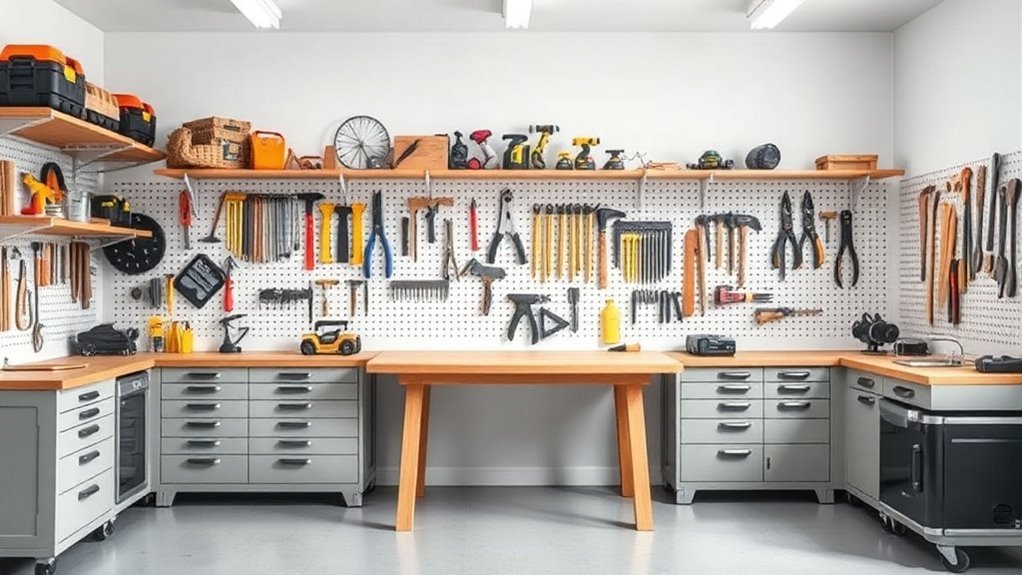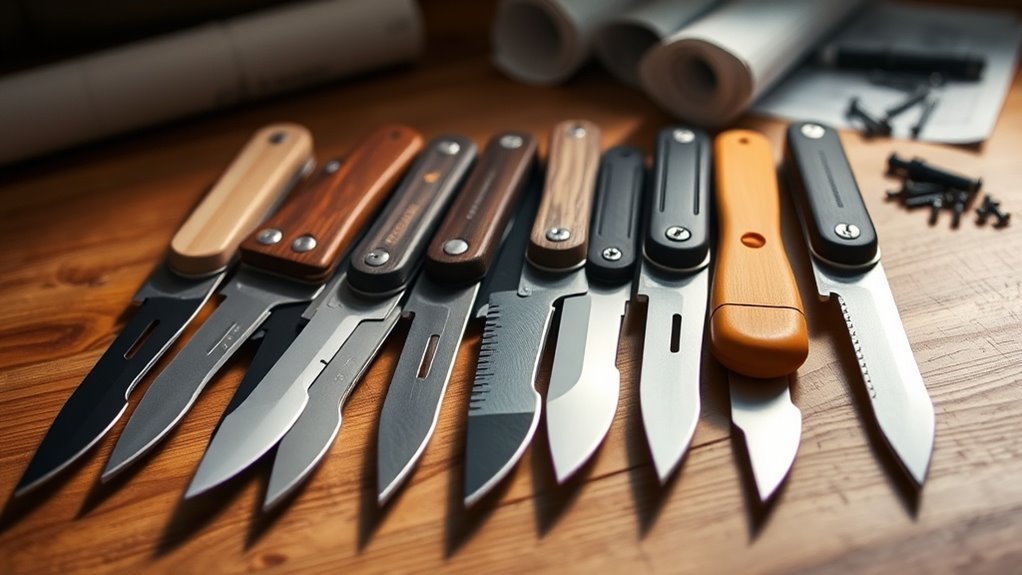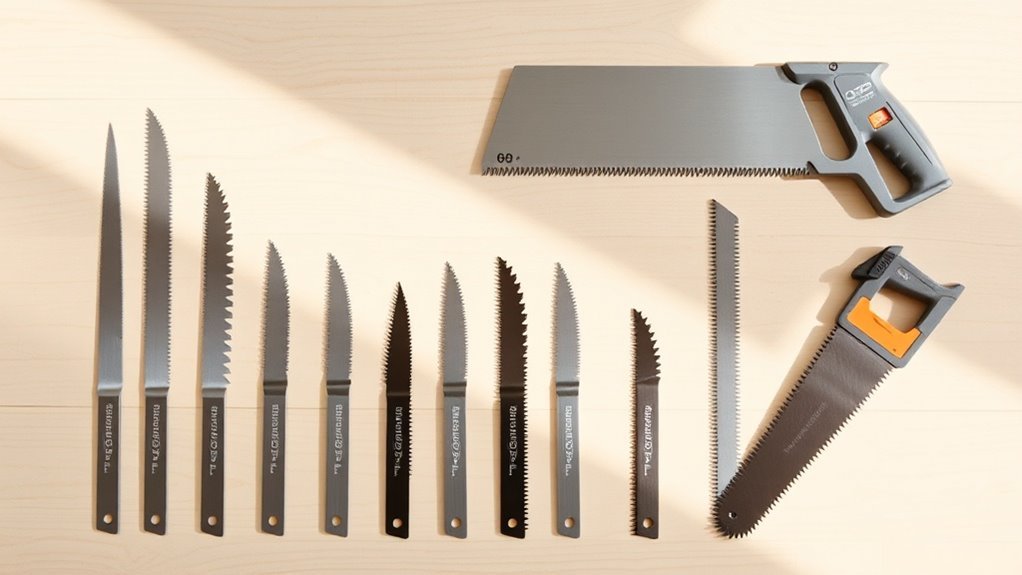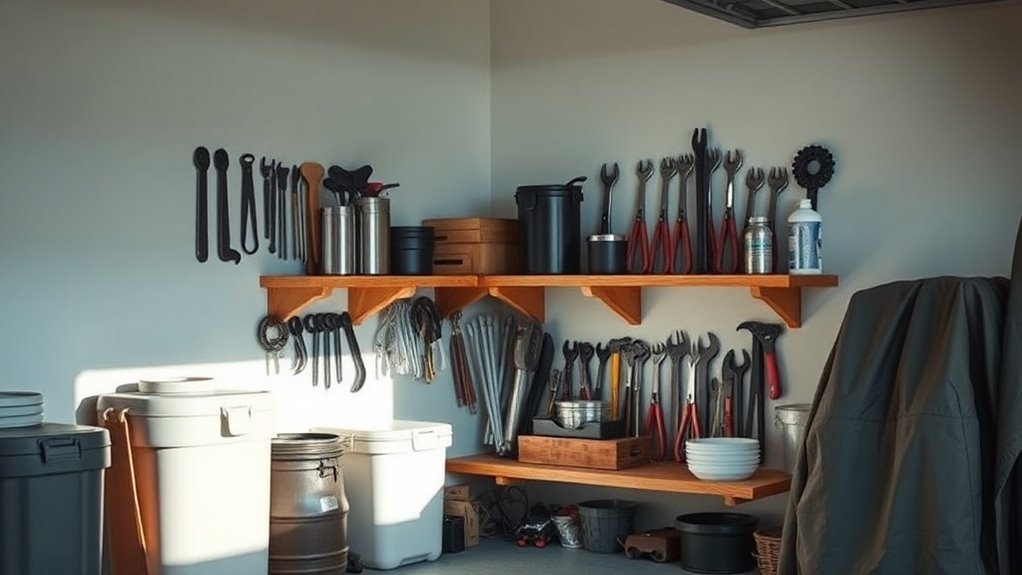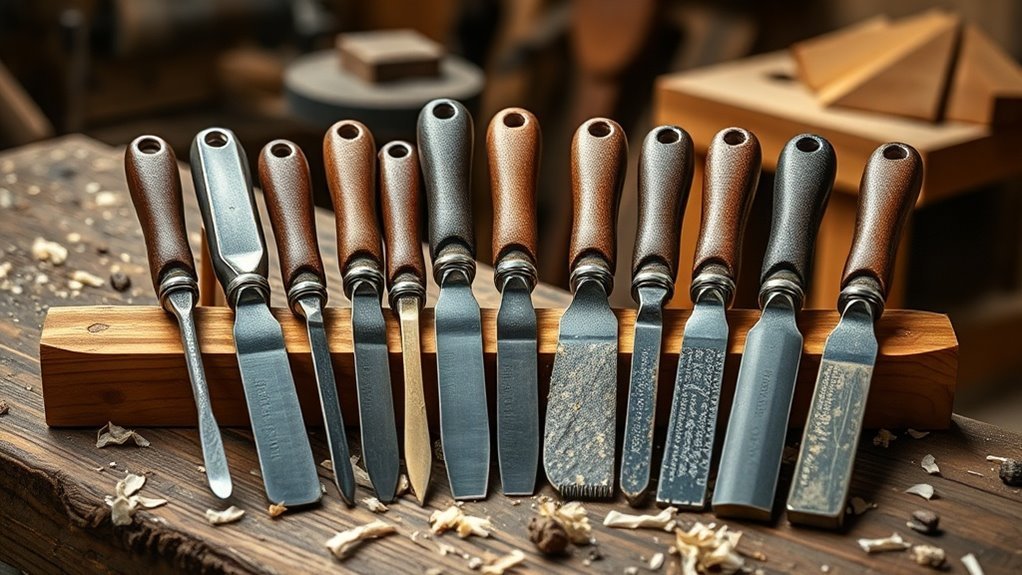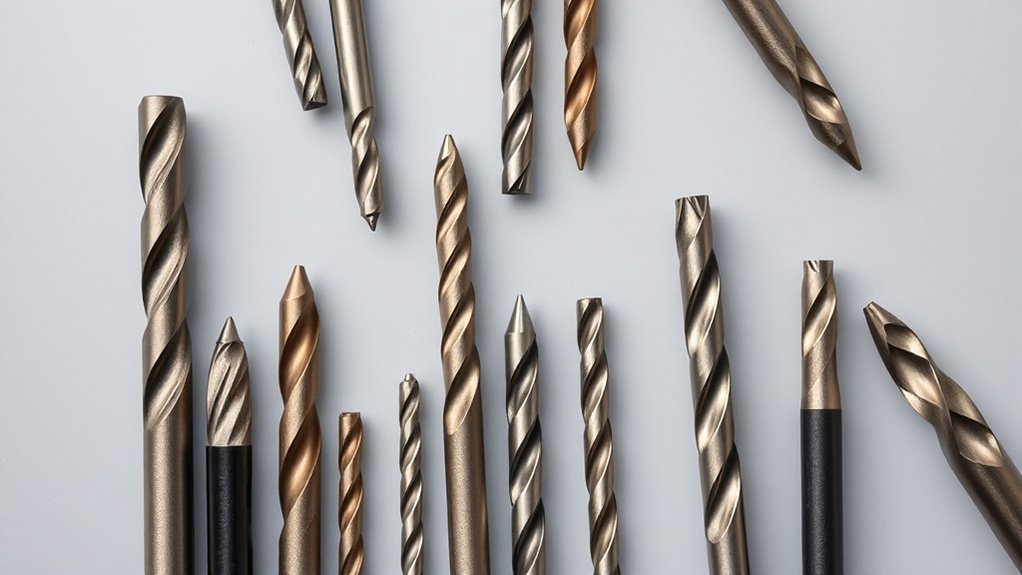How Different Types of Pliers Are Designed for Specific Tasks

Different types of pliers are designed to tackle specific tasks, enhancing your efficiency. Slip joint pliers offer versatile gripping power, while needle nose pliers excel in tight spaces. Wire cutters guarantee clean cuts for electrical work, and crimping pliers create secure connections. Locking pliers provide hands-free clamping, and flat nose pliers aid in manipulating materials. Diagonal cutters give you control when cutting wire. There’s a lot more to discover about how each type can benefit your projects.
Key Takeaways
- Slip joint pliers feature an adjustable jaw to accommodate various object sizes, making them versatile for plumbing and electrical tasks.
- Locking pliers provide hands-free clamping with a secure grip, ideal for tasks like holding sheet metal or tightening pipes.
- Needle nose pliers have long, tapered jaws designed for tight spaces, useful for intricate repairs and jewelry making.
- Diagonal cutters are specifically designed with angled jaws, enabling efficient cutting in confined areas while ensuring clean edges.
- Crimping pliers apply precise pressure for stable wire connections, essential for reliable electrical work across various projects.
Slip Joint Pliers: Versatile Gripping Power
When it comes to tackling various gripping tasks, slip joint pliers stand out as a highly versatile tool in your toolbox. Their adjustable jaw allows you to grip different sizes of objects easily, making them ideal for a range of jobs.
Whether you’re working on plumbing, electrical tasks, or automotive repairs, you can quickly adjust the pliers to fit the job, minimizing the need for multiple tools. The angled design enhances leverage, ensuring you get a firm grip without excessive effort.
Plus, the sturdy construction offers durability, so you can rely on them for heavy-duty tasks. With slip joint pliers, you won’t just have a tool—you’ll have a reliable partner for countless projects around your home or workplace. Utilizing hand tools like slip joint pliers can provide greater precision and control, enhancing the quality of your work in a way that power tools sometimes can’t match.
Needle Nose Pliers: Precision in Tight Spaces

Although you may face tight spaces during various projects, needle nose pliers can be a lifesaver. Their long, tapered jaws allow you to reach into confined areas that standard tools can’t access. This means you can tackle intricate tasks with ease, whether you’re crafting or repairing something.
Needle nose pliers are essential for reaching tight spaces, making intricate tasks in crafting and repairs much simpler.
Here are three specific ways needle nose pliers can help you:
- Tightening small screws in electronics, where gaps are minimal.
- Bending and shaping wire precisely for jewelry making or delicate crafts.
- Gripping small components securely while you assemble intricate models or mechanical devices.
With this tool in your kit, you’ll find those tricky spaces become much easier to navigate!
Wire Cutters: Clean Cuts for Electrical Work
When you’re working with electrical projects, having the right wire cutters is essential for achieving clean cuts. You’ll want to learn about different types of wire cutters, proper cutting techniques, and important maintenance tips to keep your tools in top shape. Effective wire cutting is crucial for continuity testing since it ensures that connections are clean and reliable. Let’s explore how to make those precise cuts safely and efficiently.
Types of Wire Cutters
A variety of wire cutters exists to suit different electrical tasks, each designed for precision and efficiency.
You’ll want to choose the right one to get the job done effectively. Here are three common types you’ll encounter:
- Diagonal Cutters: With their angled jaws, they’re perfect for cutting wire close to surfaces without damaging nearby components.
- Nipper Cutters: Equipped with a flat edge, these are ideal for snipping small wires cleanly and efficiently, making them great for intricate electrical work.
- Wire Strippers: While mainly used for removing insulation, they often have a built-in cutting edge to make quick work of smaller gauge wires.
Choosing the right cutter makes a world of difference in your electrical projects.
Proper Cutting Techniques
Selecting the right wire cutter is just the first step; mastering proper cutting techniques guarantees you achieve clean, efficient results in your electrical work.
Start by positioning the wire cutter’s blades around the wire you’ll cut, ensuring they’re aligned properly. Firmly squeeze the handles, applying even pressure to cut through the wire without twisting or bending it.
For best results, use cutters designed for the specific gauge of the wire. Avoid cutting too close to the insulation, as this can damage it. Always keep your hands clear from the wire’s path to prevent injury.
After cutting, inspect the edge to confirm it’s even and clean. Good cutting techniques not only improve your work’s quality but also enhance safety.
Maintenance and Safety Tips
Keeping your wire cutters in top shape is essential for achieving clean cuts and ensuring safety during electrical work. Proper maintenance not only extends the life of your tool but also minimizes risks. Here are three quick tips:
- Regular Cleaning: Wipe the blades with a soft cloth after each use to remove dirt, oils, and debris.
- Lubrication: Apply a few drops of oil to the pivot points every month, allowing smooth operation and preventing rust.
- Sharpness Check: Inspect the cutting edges regularly. If you notice any dullness, sharpen or replace the blades to maintain optimal cutting performance.
Crimping Pliers: Secure Connections for Wiring
Crimping pliers are vital tools when it comes to creating secure, reliable connections for wiring. Whether you’re working with electrical wires or connecting terminals, these pliers guarantee that your connections are tight and stable.
Crimping pliers ensure tight, stable connections for reliable wiring, essential for any electrical project.
You’ll appreciate their ability to apply precise pressure, forming a solid bond between wire and connector.
When choosing crimping pliers, look for features like adjustable settings and comfort grips. This’ll make your job easier and more efficient.
Proper technique is significant – position the wire correctly in the crimping area and apply consistent pressure. Additionally, selecting the right tool for different wire and connector types is crucial to ensure secure and reliable connections.
Locking Pliers: Hands-Free Clamping Efficiency
Locking pliers are a game changer when you need hands-free clamping. They work by using a simple lever mechanism to lock onto objects securely, freeing up your hands for other tasks.
With key features like adjustable jaws and various sizes, they’re perfect for gripping, twisting, and even as a makeshift wrench in common applications.
How They Work
Imagine securing a workpiece effortlessly—this is the magic of locking pliers. They use a simple yet effective mechanism to grip objects tightly, leaving your hands free for other tasks.
Here’s how they work:
- Adjustable jaw: You can easily adjust the opening width to fit various sizes of materials, ensuring a snug fit.
- Clamp mechanism: Once positioned, squeezing the handles activates the clamp, locking the jaws around the workpiece.
- Release lever: When you’re done, a quick press on the release lever disengages the lock, freeing your work without hassle.
This design not only provides a secure grip but also enhances your efficiency, making locking pliers a must-have tool in any toolbox.
Key Features
When you need a tool that simplifies your work, locking pliers stand out with their key features designed for hands-free clamping efficiency.
The unique locking mechanism allows you to secure materials tightly with just a squeeze, freeing your hands for other tasks. This means you can focus on aligning parts or applying pressure without constantly holding the tool.
The adjustable jaw width lets you grip various sizes, making these pliers versatile for different jobs. Plus, the textured grip guarantees comfortable handling, reducing hand fatigue during extended use.
Say goodbye to awkward setups or constant repositioning; with locking pliers, you’ll enjoy a steady, reliable grip that speeds up your work and enhances your productivity.
Common Applications
There’s no denying that locking pliers make tasks easier, especially in scenarios that require a secure grip.
They’re perfect for hands-free clamping, giving you the freedom to work with both hands. Here are three common applications where locking pliers shine:
- Holding Sheet Metal: Locking pliers clamp firmly, preventing slips while you drill or weld.
- Tightening or Loosening Pipes: These pliers provide the torque needed to grip smooth surfaces where standard tools may fail.
- Removing Broken Bolts: Locking pliers can grip the remnants tightly, allowing for easy extraction.
With their ability to hold objects securely, locking pliers enhance your efficiency and precision in any project.
Whether you’re a DIY enthusiast or just tackling a quick fix, these tools are indispensable.
Flat Nose Pliers: Ideal for Manipulating and Shaping
Flat nose pliers, with their broad jaws and sturdy grip, are essential tools for anyone looking to manipulate and shape various materials. You’ll find these pliers particularly useful for tasks that require precision and control, such as forming wire or bending small components. Their flat surfaces allow for a firm grasp without slipping, making them perfect for grasping flat or angled objects.
Here’s a quick overview of the key features:
| Feature | Description | Benefit |
|---|---|---|
| Broad Jaws | Flat, wide gripping surfaces | Enhanced stability and support |
| Sturdy Build | Durable construction | Long-lasting performance |
| Versatile Design | Suitable for multiple tasks | Useful in various DIY and craft projects |
| Comfortable Grip | Ergonomic handle designs | Reduced hand fatigue during use |
Diagonal Cutters: Cutting Wire With Ease and Control
Diagonal cutters, often called wire cutters, are designed for precision and efficiency in cutting through various wires and small materials. You’ll appreciate their unique angled jaws, which allow you to get into tight spaces and make clean cuts without damaging surrounding parts.
Here are three key features that make diagonal cutters essential in your toolkit:
- Sharp Blades: The cutting edges are finely honed for a clean slice, helping you avoid frayed ends.
- Ergonomic Handles: Designed for comfort, they give you a firm grip, minimizing hand fatigue during prolonged use.
- Compact Size: Their smaller stature means you can easily maneuver them in cramped areas, perfect for intricate electrical work.
Understanding Ohm’s Law can enhance your effectiveness in using diagonal cutters, as it relates to the electrical components you may be working with. With diagonal cutters, you can tackle your wiring tasks effortlessly!
Questions
What Materials Are Typically Used to Make Pliers?
Pliers are typically made from high-carbon steel for strength and durability, often coated with chrome or nickel for corrosion resistance. The handles are usually rubber or plastic for a comfortable, non-slip grip when you’re using them.
How Do You Maintain and Clean Pliers?
You should regularly clean your pliers with a cloth to remove dirt and debris. Lubricate the joints with a light oil to prevent rust, and store them in a dry place to guarantee longevity.
Are There Safety Tips When Using Pliers?
Yes, there’re several safety tips. Always wear eye protection, keep your fingers away from the jaws, and don’t use pliers for unintended tasks. Inspect them regularly for damage to avoid accidents while working.
Can Pliers Be Used for Tasks Outside Their Intended Purpose?
Yes, you can use pliers for tasks outside their intended purpose, but it’s risky. They might damage materials or lead to accidents. Always consider the potential consequences and choose the right tool for the job instead.
What Brands Are Recommended for Quality Pliers?
For quality pliers, you can’t go wrong with brands like Klein Tools, Channellock, or Irwin. They’re known for durability and performance, making them reliable choices for any DIY project or professional use.
Conclusion
To conclude, understanding the unique designs of different pliers can greatly enhance your efficiency and precision in various tasks. Did you know that slip joint pliers have been a staple in toolboxes since the late 19th century? Their versatility makes them a favorite, but each type has its own specialty. So next time you’re tackling a project, choose the right pliers for the job—it can make all the difference in achieving professional-quality results.

